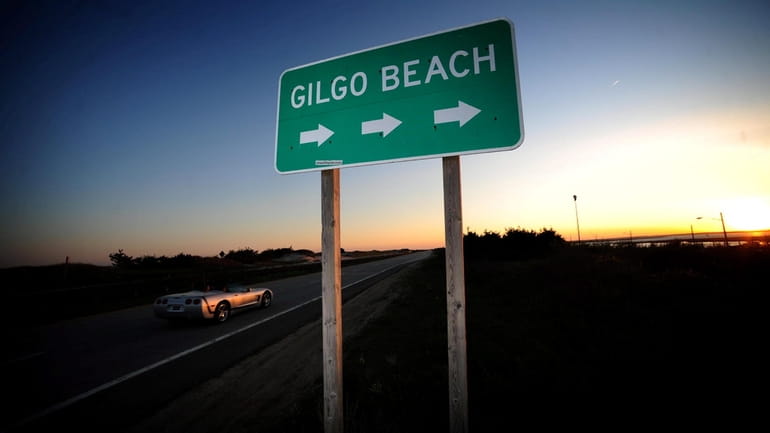Gilgo Beach killings: City ME used 9/11 techniques to help with Gilgo Beach cases

A sign along the Ocean Parkway points to Gilgo Beach in May 2011. Credit: Newsday / Thomas A. Ferrara
The New York City Office of the Chief Medical Examiner played a significant role in the identification and forensic examination of the Gilgo Beach killing victims, employing methods developed after 9/11, officials told Newsday.
In an interview this month, Suffolk County District Attorney Ray Tierney noted that a federal grant given to the New York City medical examiner for forensic and anthropological investigation also was used for the Gilgo Beach cases. The homicides were examined because the grant required that New York City make its expertise available to other counties in the state, Tierney said.
“That is why New York [Office of the Chief Medical Examiner] was involved,” Tierney said.
Julie Bolcer, a spokeswoman for the city's Office of the Chief Medical Examiner, confirmed that a grant from the federal National Institute of Justice for fiscal 2010 was in part used for the examination of 11 bodies associated with Gilgo Beach. The work, according to a summary Bolcer provided, included recovery of some of the remains and laboratory analysis of all 11 bodies, including efforts to make identifications.
WHAT TO KNOW
- The New York City Office of the Chief Medical Examiner played a significant role in the identification and forensic examination of the 11 Gilgo Beach killing victims, employing methods developed after 9/11, officials told Newsday.
- Suffolk County District Attorney Ray Tierney noted that a federal grant given to the New York City medical examiner for forensic and anthropological investigation also was used in all the Gilgo cases.
- The homicides were examined because the grant required that New York City make its expertise available to other counties in the state, Tierney said.
Rex A. Heuermann, 59, of Massapequa Park, was arrested on July 13 on charges he murdered three of the victims: Megan Waterman, Amber Costello and Melissa Barthelemy. The remains of all three were among those found along a stretch of the barrier island comprising Gilgo and Tobay beaches in December 2010. The three sets of remains were found bound with tape or belts and burlap. Heuermann has pleaded not guilty.
Reports related to the forensic examination of the three bodies by the city's Office of the Chief Medical Examiner, as well as by the Suffolk County crime lab, are expected to be turned over to Heuermann’s defense attorneys as they prepare for his trial, which has yet to be scheduled.
According to a summary of work done by the New York City medical examiner in the Gilgo Beach case and made available to Newsday, an anthropologist from the office assisted in the recovery of some of the remains and did laboratory analysis of all 11 bodies. The analysis by the New York City Office of the Chief Medical Examiner provided biological profiles such as age, sex, height and physical characteristics of the bodies in an effort to compare them with missing persons cases.
DNA analysis was able to identify six of the bodies. Bolcer said the DNA analysis was supervised by Mark Desire, assistant director of forensic biology, and the anthropological study by Bradley Adams, the resident forensic anthropologist with the Office of the Chief Medical Examiner.

Rescuers searching for victims and survivors of the terror attack at The World Trade Center on Sept 13, 2001. Credit: Newsday/Viorel Florescu
In a telephone interview, Desire said the techniques developed after Sept. 11 were used in the Gilgo analysis. The city medical examiner's office over the years has specialized in identifying degraded remains and that expertise is widely shared, Desire noted.
“It is great to help out our partners, and the techniques we have we share all over the world,” Desire said. “We learned how to generate DNA from very tough bone samples.”
Anthropological analysis also documented the trauma some of the 11 sustained, particularly with victims who suffered dismemberments. Although the summary didn’t identify the dismembered victims, two of them were later identified as Valerie Mack and Jessica Taylor, whose remains were found scattered in Manorville as well as along Ocean Parkway.
Another victim, a woman known as “Peaches” because of a tattoo on her remains, is currently the subject of a genetic genealogy search by the FBI. The remains of a toddler who was Peaches' child and that of a man also remain unidentified.
Earlier this month, Tierney announced that investigative genetic genealogy helped identify Karen Vergata, 34, also known as “Fire Island Jane Doe,” as another person whose remains were found in part in the area of Gilgo Beach, as well as Fire Island.
In a 2018 interview with Newsday, Bradley Adams, an anthropologist with the city's medical examiner's office, said federal grant money also was used in an effort to identify 50 human remains disinterred from Hart Island, the city burial ground for unidentified people.
The use of forensic science in helping identify the Gilgo Beach victims has enabled their families to know what happened to their loved ones.
"It is nice to have closure," said Brenda Breen, the stepsister of Karen Vergata.
"To me, it is miraculous, it gives me chills to know how science [can work]," said Tricia Hazen, the half-sister of victim Valerie Mack, who was identified in 2020.

